| Title | Image | Summary of text |
|---|---|---|
| Goeree - Natural Design - Page 151 |  | The text discusses the mouth's functions and metaphorical significance. Apuleius describes it as an entrance and exit for emotions, words, and air. It humorously compares mouth sizes, associating small mouths with femininity and beauty, and larger mouths with soldiers and fools. |
| Goeree - Natural Design - Page 152 |  | The text discusses the characteristics and functions of human lips and mouths. It describes how certain physical traits, like a concave mouth, have been historically viewed as indicative of moral traits, such as fickleness or cowardice. Additionally, it explores the practical functions of lips in speaking and eating, also touching on their symbolic roles in communication. |
| Goeree - Natural Design - Page 153 |  | The text discusses the idea that the movement of the lips is crucial for clear speech and communication, citing historical and cultural practices. It mentions how the lips were covered during mourning to prevent clear expression and how visual observation of speech movements enhances understanding. The text also references medical writings and anecdotes that support the power of visual cues in understanding speech. |
| Goeree - Natural Design - Page 154 |  | This passage discusses how paintings can convey emotions and actions universally understood by observers, reflecting the painter's intention. It highlights how Jan van Eyck's artwork skillfully depicted musical scenes, allowing knowledgeable viewers to identify singers' roles through subtle physical cues. The text also emphasizes the challenges of interpreting speech through lip-reading due to language differences. |
| Goeree - Natural Design - Page 155 |  | The text discusses how the articulation of actions and emotions often relies more on mental inclination than language. Through examples of words like "Water" in Dutch, Latin, and French, the text illustrates how words with similar meanings require different lip movements based on the language. Additionally, it mentions the important role of the mouth, lips, and tongue in speech across various languages. |
| Goeree - Natural Design - Page 156 |  | This text discusses the moral and aesthetic perceptions of lips and facial expressions. It highlights how lip size and mouth shape can be interpreted as signs of character and virtues, like courage or timidity. The description also touches on the social interpretations of these traits, drawing comparisons to animal features and behaviors. |
| Goeree - Natural Design - Page 157 |  | The text discusses various interpretations of lip and mouth shapes and their suggested correlations with personality traits. Wide mouths may indicate impertinence, while small mouths suggest modesty. It also covers how the tongue, as a master of speech and taste, functions and interacts with different food textures and temperatures. |
| Goeree - Natural Design - Page 158 |  | The text discusses how the taste can be affected by different foods and drinks, noting that some foods can make beer or wine taste better. It explains how spices and flavors are added to make bland foods more palatable. Additionally, it mentions that tobacco smoking influences taste, making beer more soothing and preferable to some people. |
| Goeree - Natural Design - Page 159 |  | The text discusses the properties of flavors and how they are made, focusing on hard and adherent particles versus soft and malleable ones. It explains why certain substances, despite being soft, impart little taste due to their smoothness and inability to stimulate taste buds. Additionally, it describes the anatomical function and versatility of the tongue. |
| Goeree - Natural Design - Page 160 |  | The text discusses the role of the tongue in speech and chewing, highlighting how it moves food with ease thanks to saliva. It explains that various muscle movements affect speech, leading to potential speech disorders such as stuttering or lisps if the tongue is too tight or loose. Additionally, solutions like using weights in the mouth are suggested for managing unruly tongue movements, emphasizing the impact of tongue size and flexibility on speech clarity. |
| Goeree - Natural Design - Page 161 |  | The text discusses how teeth support speech and notes the indicators of sound in evaluating expressions. Diogenes observed the irony in people's reliance on appearance over substance, emphasizing the importance of sound judgment. The text then details the typical count and function of teeth in the jaw. |
| Goeree - Natural Design - Page 162 | 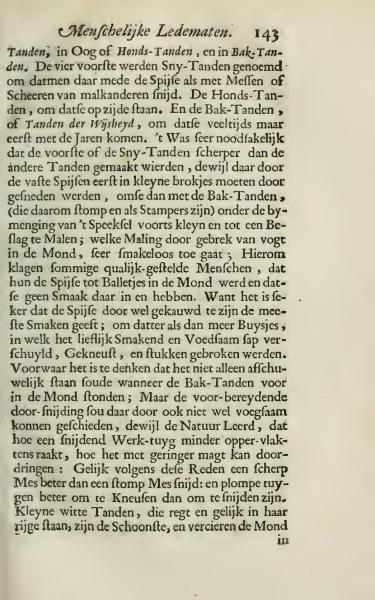 | The text discusses different types of teeth, including incisors, canines, and molars, and their functions in the process of chewing and breaking down food. It highlights the importance of incisors being sharper for efficiently cutting food, while molars, due to their blunt nature, grind the food with the help of saliva. Additionally, it mentions the aesthetics of small, white, and well-aligned teeth. |
| Goeree - Natural Design - Page 163 |  | The text discusses the importance of teeth in aesthetics, describing how missing or discolored teeth can affect appearance. It also recounts a humorous tale of a doctor whose dentistry was tested during laughter, and the dangers of a potentially lethal bite. A separate incident involves a man bitten by a thief, leading to a fatal infection. |
| Goeree - Natural Design - Page 164 |  | The text discusses the role of saliva in digestion and its connection to the nature of the blood, implying that spirits reside in saliva. It also describes how infected saliva from rabid dogs or mad humans can cause an intense reaction in a victim's blood, comparing it to a spark in tinder. The passage concludes by explaining why such harmful saliva does not affect the mad person or animal themselves. |
| Goeree - Natural Design - Page 165 |  | The text discusses the ability to infer traits and life predictions from teeth and facial features. Aristotle's belief is mentioned that foresight can be derived from teeth, but this kind of wisdom has its limits. The text also highlights various chin shapes and their impact on facial appearances. |
| Goeree - Natural Design - Page 166 |  | The text discusses the aesthetics and symbolism of chins and their implications for character judgments in men and women. It notes that a small chin is often seen as attractive in women but comes with a warning due to a perceived 'serpentine nature.' Different forms of chin shapes are linked to characteristics such as masculinity or bad morals, with cultural references to philosophers like Aristoteles. |
| Goeree - Natural Design - Page 167 |  | This excerpt addresses artistic techniques related to the structure and portrayal of the human neck and head in art. It discusses how the elongated form of the neck aids in the free movement of the head, akin to a pivot, and the importance of observing this in artistic portrayals, as well as understanding discrepancies in artwork. Additionally, it explains the neck's role in facilitating sound, noting differences between creatures with and without necks. |
| Goeree - Natural Design - Page 168 |  | The text explores how physical characteristics, particularly of the neck, may indicate certain personality traits or behaviors. A strong, thick neck is associated with strength, while a thin or crooked neck may suggest weakness or deceit. The text draws comparisons between animals and humans, suggesting cultural perceptions of different body types. |
| Goeree - Natural Design - Page 169 |  | The text discusses the symbolism of different types of neck bends in people, suggesting their natural inclinations or personalities. A neck bent to the right is seen as studious, while one bent to the left indicates excess or unchastity. There is mention of unyielding necks being a sign of stubbornness, tied to Biblical references of Isaiah and Jeremiah. The concept is also extended to imply characteristics like willingness or defiance. |
| Goeree - Natural Design - Page 170 |  | The text discusses the importance of arms and hands in articulating actions and providing strength, drawing a comparison to divine influence expressed through arms and hands in scripture. It highlights the necessity of hands and arms in conveying emotions and assisting in physical activities like walking and balancing. The text also notes the duality of human limbs and how they help us maintain balance, similarly to how tightrope walkers use tools for stability. |
| Goeree - Natural Design - Page 171 |  | The passage discusses the importance and function of fingers and hands, highlighting their ability to perform different types of grasping due to varying finger lengths. It emphasizes that fingers allow for dexterity and adaptability in handling objects and mentions the difficulty encountered when using fingerless gloves. The text concludes by noting that fingers are essential for sensing, counting, and performing divided tasks. |
| Goeree - Natural Design - Page 172 |  | The text discusses the importance and functions of the human hand, particularly the thumb, highlighting its essential role in grip and handling objects. It explains how phrases like "He has it on his thumb" imply mastery of a subject. The text also touches on the varying lengths of fingers and their roles in performing different tasks. |
| Goeree - Natural Design - Page 173 |  | The text describes the significance of hands in human expression and culture. It discusses how the beauty of hands is linked to their proportional structure and conveys ideas about the meanings attributed to hand gestures in ceremonies. Additionally, it explores the dual nature of fingernails as both ornamental and practical elements, even associating them with symbolic power and potential harm. |
| Goeree - Natural Design - Page 174 | 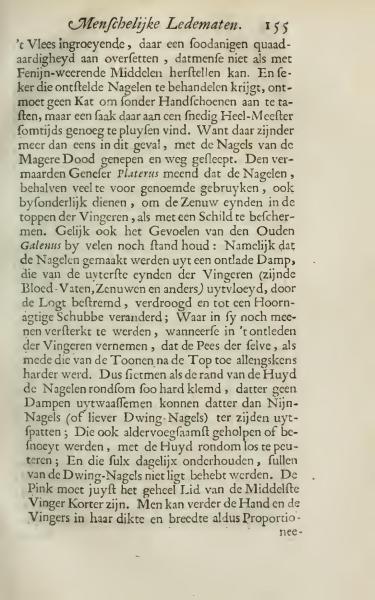 | The text discusses the significance of nails and their medical treatment. It describes the practices recommended by historical medical experts, such as Platerus and Galen, regarding nails' protective and structural roles. The passage outlines conditions affecting nails, their treatment, and their proportionality on human fingers. |
| Goeree - Natural Design - Page 175 |  | The text discusses the proportions of fingers, detailing how their widths compare to their lengths and how they vary between different fingers. It explains how the hand is structured, noting how the thumb and the inner part of the hand align, and provides measurements for dividing the hand's sections. Additionally, it mentions how palm readers often ascribe specific names to lines in the palm, with the 'Life Line' being one such example. |
| Goeree - Natural Design - Page 176 |  | This text discusses palmistry, a practice of interpreting characteristics and fortunes through lines on the palm, with each line assigned to a different planet. It claims that these lines can reveal insights into a person's life, intellect, passions, virtues, and vices. The text expresses skepticism toward these interpretations but acknowledges their existence. |
| Goeree - Natural Design - Page 177 |  | The text explores the function and nature of hands, associating various traits and characteristics with different hand shapes and sizes. It suggests that large hands indicate strength, while small hands suggest delicacy, and long fingers suggest craftsmanship. Additionally, the text reflects on how speech can be articulated with or without hand gestures, following Aristotle's teachings. |
| Goeree - Natural Design - Page 178 | 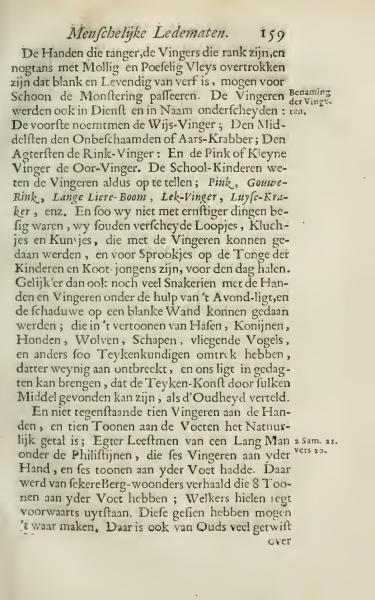 | This text discusses the anatomy and playful uses of the fingers, naming each finger with traditional and whimsical terms. The passage mentions both practical and humorous roles of fingers, including tales of individuals with more than the usual number of digits. It reflects both scientific observation and folklore regarding extraordinary human features. |
| Goeree - Natural Design - Page 179 |  | The text discusses the historical preference and significance of right-handedness across cultures, noting that many nations assign greater honor and capability to the right hand. It questions whether this distinction is natural or just a matter of tradition and voluntarily chosen names. The text suggests that similar observations are made in animals regarding the initial step in movement, though this is not universally accepted as fact. |
| Goeree - Natural Design - Page 180 |  | The text discusses the characteristics of horses, particularly their ability to carry loads smoothly. It also describes the differences between right-handed and left-handed people, noting that traditional education favored right-handedness. Those who deviated often had different social interactions. |
| Goeree - Natural Design - Page 181 |  | The text discusses the challenges of maintaining order in formations, whether military or metaphorical, depending on whether individuals align as 'Slinx' or 'Right'. It considers the role of habit and writing method in determining one's alignment and capability. The discussion extends to the analogy of human arms as 'Hand-trees'. |
| Goeree - Natural Design - Page 182 |  | The text discusses the roles and movements of human limbs, focusing on the arms and hands. It explains the importance of muscle and bone structure in performing tasks and how physical traits such as the length of arms can indicate personality or capability. It also touches on the differences in function and appearance of breasts between men and women. |
| Goeree - Natural Design - Page 183 |  | The text discusses the structure and function of human breasts, particularly in women, highlighting their proximity to the heart and their role in warmth, beauty, and nursing. It notes anatomical differences between humans and animals, especially the unique position of breasts in humans. The discussion includes the importance of breasts for balance and symmetry in the body and considers both aesthetic and practical aspects, such as their behavior during nursing. |
| Goeree - Natural Design - Page 184 | 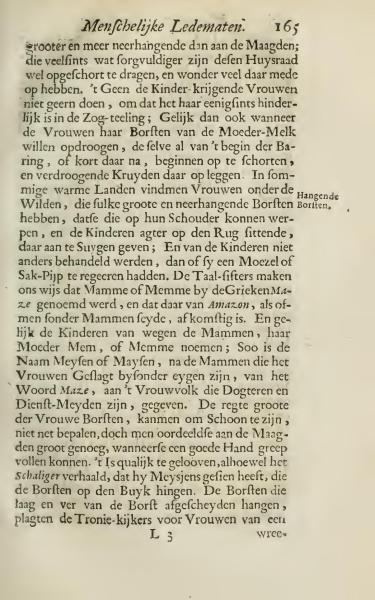 | The text discusses how women's breasts vary in size and shape, especially comparing those of maidens and mothers. It mentions traditional practices for managing and drying the breasts among different cultures. The etymology of terms related to 'breast' is explored, along with historical references, such as the Amazons. |
| Goeree - Natural Design - Page 185 |  | The text discusses the growth and characteristics of breasts in both men and women, noting how regular massaging can promote development. It also describes the differences between the breasts of fertile and infertile women and includes observations about men's breasts. The text highlights the superficial beauty of breasts, citing Augustine's observations that men's breasts serve no practical purpose. |
| Goeree - Natural Design - Page 186 |  | This text discusses various observations and myths concerning lactation in men, citing testimonies and stories to support these claims. One example involves Alexander Benedictus, who told of a man nursing a child after losing his wife, supposedly producing milk. The function of male breasts is noted as still not entirely understood, with descriptions of nipples in nursing women and perceptions of men with noticeable chests. |
| Goeree - Natural Design - Page 187 |  | The text discusses perceptions of physical attributes like the chest and abdomen, viewing a bony chest as a sign of strength, whereas a soft chest might indicate effeminacy. It also comments on how a narrow chest is historically seen as a sign of intelligence. The text explains how the abdomen is structured to support various bodily functions and highlights social attitudes towards these physical traits. |
| Goeree - Natural Design - Page 188 |  | This text discusses sudden cramps in the muscles of the human body, particularly those affecting the abdomen and their impact on breathing. It explains the discomfort caused by muscle contractions during events like sneezing or excessive laughter, relating these to medical beliefs about certain conditions historically referred to as 'Night-Mare'. The text explains how these physical reactions occur, noting both involuntary and sudden muscle movements. |
| Goeree - Natural Design - Page 189 | 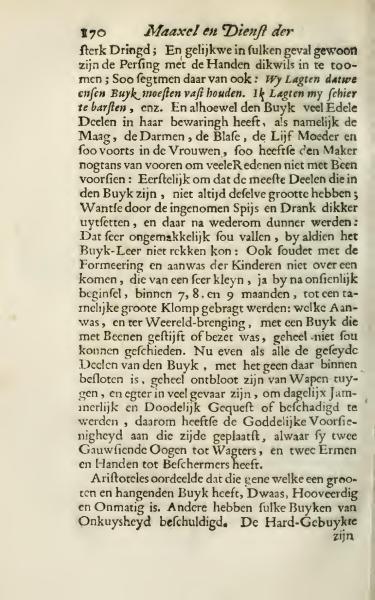 | The text discusses the function and importance of the human belly, emphasizing how it houses vital organs and allows for growth during pregnancy due to its natural stretchability. It notes the vulnerability of the belly, lacking bone protection, and describes the natural human anatomy suggesting divine protection through bodily features like hands and eyes. Additionally, the text shares Aristotle’s opinion on the character of individuals with large bellies. |
| Goeree - Natural Design - Page 190 |  | The text discusses the role of the navel and its function during fetal development. It explores historical beliefs about how a fetus is nourished and mentions theories comparing nourishment through the umbilical cord, skin, and mouth. Additionally, it briefly touches upon the notion that Adam and Eve might have been created without navels. |
| Goeree - Natural Design - Page 191 |  | This text discusses the depiction of navels in art, referencing that Adam was painted with one by famous artists like Raphael and Michelangelo. It highlights the aesthetic value of a well-proportioned belly, focusing on maintaining natural figures in art. The text advises artists not to apply the beauty of a virgin’s belly to that of a mother’s, emphasizing consideration of natural aesthetics and proportion. |
| Goeree - Natural Design - Page 192 |  | The text discusses the imperfections of things, humorously critiquing societal norms and the depiction of human figures in art. It mentions a woman's lament over her beauty lost after childbirth and contrasts it with artistic conventions of the time. The text also critiques the hypocrisy of clothing and decency in art, advocating for honesty in the depiction of the human form. |
| Goeree - Natural Design - Page 193 |  | The text discusses the anatomical and functional roles of thighs and legs for humans and animals. It emphasizes the support and movement these body parts provide, describing how they bear the body's weight and contribute to balance and mobility. Additionally, it compares various animal anatomies to human anatomy, with notes on the ideal characteristics of thighs for both male and female figures. |
| Goeree - Natural Design - Page 194 |  | This text discusses the characteristics of human limbs, asserting that those with rough and hairy thighs often resemble satyrs. It describes the functionality of the legs and knees in bending suitable for movement and posits that short-legged individuals may have malevolent tendencies. Additionally, it discusses historical views, noting that the shin bone was formerly used to make flutes and symbolizes strength, while small shins may indicate weakness. |
| Goeree - Natural Design - Page 195 |  | The text discusses the anatomical features of knees and feet, noting that thick and round knees are preferable in women, while inward-bent knees indicate femininity. Feet are described as essential for balance and mobility, with the ability to bend in multiple places aiding movement. Proper foot movement, influenced by the structure of bones, helps in walking and leaving clear footprints in various terrains. |
| Goeree - Natural Design - Page 196 |  | The text discusses the observation of footprints, particularly those made by bare feet, and how heels are seldom seen in such tracks. It highlights the cleverness of escapees and bears in avoiding detection through their movement. Additionally, it reflects on the comparison between human limbs and architectural columns, focusing on the distinctive characteristics and beauty of human feet, more noted in art than daily life. |
| Goeree - Natural Design - Page 197 |  | This section discusses various characteristics of feet, suggesting associations with personality traits. It describes cultural practices like foot binding and indicates that foot form may reflect intelligence or social rules. The text also includes anecdotes about foot size and shoe fitting. |
| Goeree - Natural Design - Page 198 |  | The text provides observations on human toes and nails, associating their shapes and forms with personality traits and behaviors. It suggests that large and well-proportioned toes are linked to good manners, while short, thick toes are associated with carelessness and wildness. Additionally, the text comments on variations in human gait and the significance of physical features like nails in revealing character. |
| Goeree - Natural Design - Page 199 |  | The text discusses how a person's movement and gait can reveal their innate character and disposition. It describes the differences between wide and narrow steps, speed, and steadiness, and what they may indicate about a person's honesty, strength, or mindset. It also comments on philosophical views about the correlation between physical movement and nobility of character. |
| Goeree - Natural Design - Page 200 |  | This text discusses the characteristics and symbolism of different types of walking. A wide and slow walking style is seen as contemplative and indicative of successful ventures, while a short, slow walk is linked to laziness. The text gives insight into personality traits one might discern from how individuals move, such as suspicion or indecisiveness. |
COPYRIGHT © 2024 STUDY DRAWING. ALL RIGHTS RESERVED.